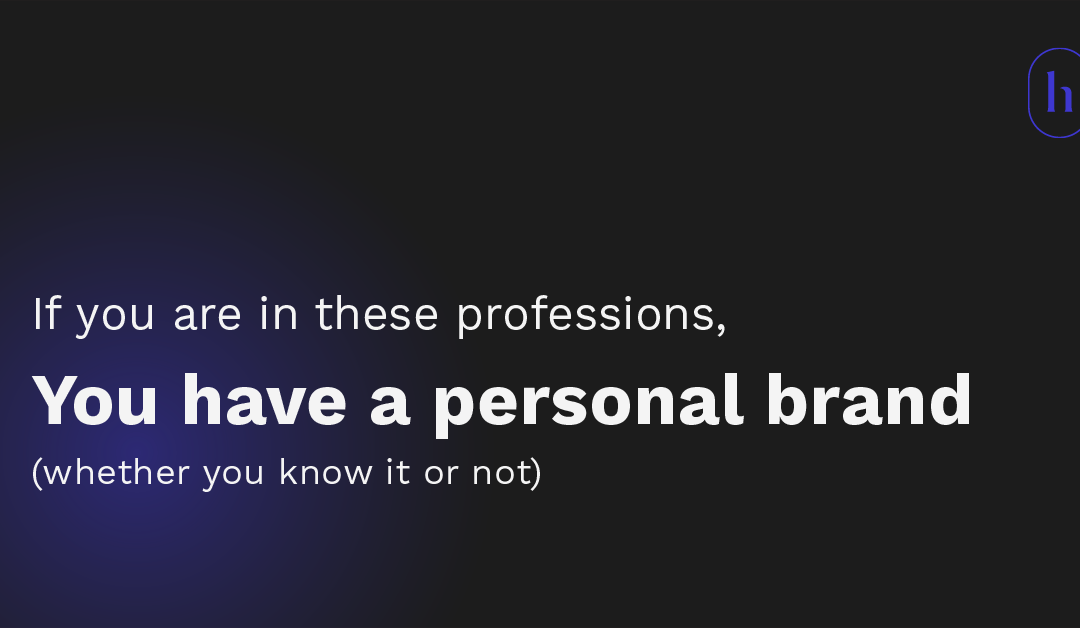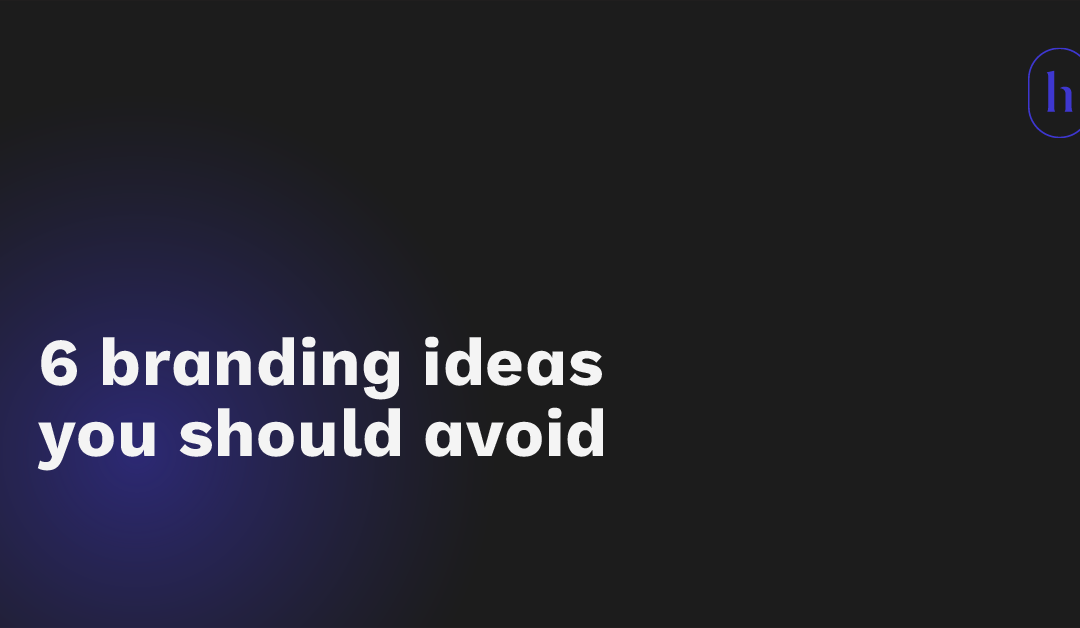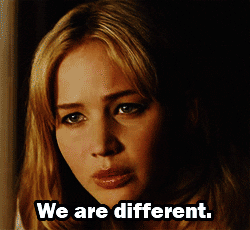No Results Found
The page you requested could not be found. Try refining your search, or use the navigation above to locate the post.

What is a personal brand? In a nutshell, it’s who your business associates* perceive you, as an individual, to be. Not your business, not your organization – YOU.
(*”business associates” can be client/customers, employees, co-workers, vendors, or the general public.)
While you may not think you have a personal brand, if you are in one of the professions listed below, you do…whether you know it or not. More importantly, if you think you don’t have a personal brand then you probably haven’t invested enough time developing your brand…and that could be hurting your business.
So, if your profession is listed below (or if you are in a similar profession) read on to find out why your personal brand is important and to learn some helpful tips for building, improving or rescuing your personal brand.
Buying or selling a home is one of the most important financial decisions people make. It stands to reason that they aren’t going to trust just anyone to help them through this process. But how do people choose their Realtor?
Primarily, they choose someone they know, or someone referred to them by friends or family. If this isn’t their first home buying/selling experience, they’ll use a Realtor they’ve worked with in the past as long as that Realtor has stayed in contact with them, or they have seen marketing and advertising that tells them they are still active in the industry.
And, if they don’t have a Realtor on top of mind? A quick Google search provides them with a long list of options. But how do they choose from the results? They evaluate personal brand.
99% of Americans don’t use a financial advisor. So, how do you capture the attention of the 1% that do (or, convince one of the remaining 99% to take the leap?)
It’s all personal brand.
Trust and understanding are crucial factors people use when choosing a financial advisor – or even whether they will begin to use a financial advisor. Potential clients will look to your personal brand to decide if they can trust you and to determine if you are someone who will understand their personal financial situation.
As a contractor, you want to be the first person who comes to mind when developers, architects, designers, and property managers have a new project. This will happen if you are reliable, do good work, complete work on time and at or under budget, and have other qualities that make completing the project easier for them, rather than harder.
How do they know if you can do this? Personal brand.
Modern day salespeople are strategic partners with their clients. They provide their clients with ongoing support and education, not only for the products or services they sell, but also on other, related topics, such as industry trends, up-and-coming technologies, competitor insights, and much, much more.
Whether you are going to be a valued partner or just another peddler of goods is conveyed in your personal brand.
As a consultant, you sell your expertise, but you also sell yourself. You may be the most knowledgeable expert in your field. However, if you have an abrasive personality, have a condescending communication style, and act as if you’d rather be anywhere but working with your client, it will significantly devalue your expertise. And, your clients will take their business elsewhere.
All of this is reflected in your personal brand.
It may not be easy, but putting work into building your personal brand is critical your business success and will pay big dividends in the long run. We’ve included some quick tips below.
However, if you are serious about building a personal brand that will position you for the greatest possible success, you should seek out the assistance of an expert. Contact us today for a free Personal Brand Audit. We’d also be happy to provide you with a quote for a full Personal Brand Development, Redevelopment or Triage.


Not all that glitters is gold, so the saying goes. Many companies feel this when they put time and money into rebranding, yet it’s still not connecting to customers. Then they are stuck trying to figure out what went wrong. Deciding to rebrand your company is an important step in growing your business and building trust with your audience. However, a few missteps in the process can have you throwing a lot of time and money at something that will not achieve your goals.
Going in without a plan, trying to copy other brands, or doing an incomplete job can bring even the most well-intentioned projects down. To help you steer clear of these missteps, we’ve compiled a list of the top 6 ideas to avoid when it comes to rebranding your company.
When you are prepping for a rebrand, the easiest place most people go for ideas is their competition. If their branding is working for them, why not try something similar?
But there is a problem with that line of thinking. If both of you look the same – why would people buy from you over them? Especially if they have already built loyalty through their brand. An important part of rebranding is about setting yourself apart from your competition and letting potential customers know why you are unique.
You’ve put a lot of hard work into your business. Sometimes even your heart and soul. You may be the face of your organization, but one common mistake in rebranding is making it all about you.
Branding is all about how you appear to others and building loyalty. And while you may love your products, what you love about them might not be what someone else does. The reasons you need it might not be the same for everyone else. There are so many types of people in the world, and you could miss out on a lot of potential customers by basing your branding just on your preferences.
Sometimes, it can be tough to connect with a potential customer from a different demographic or lifestyle than yourself. Some of these areas include:
Age
City vs. small town
Parent vs. non-parent
Single or married
Working, retired, stay-at-home
Type of career
Brand experts can help you do consumer research so you can build a brand that will appeal to a wider audience, especially ones that are not exactly like you.
Another thing to consider is the possibility that something else could attract potential customers beyond your profile. What brings someone into your business may not be the years of experience and talent you possess, but a unique product you offer that they can’t get anywhere else. Making it all about you narrows the number of people that you could potentially reach.
When some hear the word rebranding, they often think about just getting a new logo. However, the logo is only a small piece of the larger brand picture, which also includes every touchpoint with your audience, including your employees and the mission of your company.
Rebranding is not “just” anything, and part of the process is making sure every element that represents your business is of the highest professional quality to draw in new customers.
Sure, your niece’s boyfriend may be great at computers, but that doesn’t mean he should be in charge of designing your logo. There are so many things that can go wrong in this scenario. Here are a few examples:
They could produce something that you don’t care for, but you may be reluctant to express your opinion because of the personal connection, or because they are doing it as a favor or at a discount. No one wants to be using a terrible design on their marketing materials with a phony cringe-hiding smile on their face.
You could run into legal issues if they use artwork or even fonts without paying for them or making sure they are free to use.
You have limited possibilities based on their skill, rather than being able to find a designer that suits your vision.
One big thing to avoid when rebranding is being closed off to outside opinions. You are an expert when it comes to knowing about your business. But what about how others perceive it?
While it’s hard to bring in an outsider, a brand expert can help you in ways you never knew you needed.
Here’s what a brand expert brings to the table:
Years of expertise on rebranding – what works and what doesn’t
Knows the right questions to ask to reveal the heart of your business
Can find the strengths of your business and identify your mission
Discovers weaknesses in your brand and has a game plan for improvement
Has tools for testing brand awareness
Brings knowledge of the latest tools and trends for creating and promoting your brand
Though it may be tough to hear, an outside expert is not emotionally attached to branding that was in place in the past and can provide an unbiased opinion on what can be kept to tweak or what needs to be let go.
One mistake that people make while building their business’s brand is thinking that their website just serves the purpose of people finding them online. They create something with just a plain landing page and basic information, not putting a lot of thought into it.
Keep in mind that your website is the first thing people often visit before setting foot in your business or reaching out to you for more information. Your website is a salesman for your services and products, and it’s important to think about what impression that salesperson is giving.
When you hire and train an employee to represent your business, you train them on the way they should treat customers and give them all the important information they need to know to make the sale, and your website should be the same way.
Some things to consider for your website:
Does it look professional and welcoming? Or is it poorly designed or plain? The look and feel of your website will impact a visitor’s impression of your business.
Does it have all the information your potential customer needs to make a decision? Look beyond just your contact information and hours. What can they expect when they come into your business?
Are your business’s unique qualities, products and mission accurately represented on the site?
A brand expert can help ensure your website is an accurate reflection of your business and attract customers.
Creating content to promote your business is more than just listing your features and benefits. Sometimes people may not even know that they have a need for your product – how will you let them know?
Most people look for a brand, product, and service first. Then they will focus on what features and benefits set you apart from the competition. An important part of rebranding is being customer-focused in your messaging. A brand expert will help you get in the mind of your potential customers and help answer the question – what problem are they having that we will solve for them?
For example, a cell phone company may really focus their messaging on their family plans, knowing that many parents are faced with the problem of their bill going up once their teenagers are added to their plan. This marketing message helps bring customers in, and then you can sell them on your benefits and features.
Brand experts bring experience in finding the right message for your business. They know to produce clear and concise content to promote your brand.
You’re the expert at what you do, why stretch yourself thin doing something that is not normally in your wheelhouse? Bringing in a branding expert helps to ensure your business makes the best impression it can, which provides a huge return on your investment.
If you are ready to discuss what rebranding could look like for your business, we would be happy to offer you a free consultation. You can learn what the project could look like, how long it will take, and what research will be done.
Many people think a brand is just a logo and website, but it’s so much more than that. A brand is the way your organization is perceived by those who experience it. And having a bad brand influences not only your sales but the ability to attract the best employees to your company.
A strong brand:
So, what does this mean? You need to proactively manage all aspects of your brand. You can start this by grading your current branding to see how it fares when it comes to creating a positive perception of your business.
Grade the following categories from A-F (A = extremely strong, F = extremely weak)
The first category to grade your brand on is vision. This is the purpose of your company beyond making money. Having a shared vision helps you and your employees be on the same page when it comes to representing your brand. It also helps customers know what to expect when interacting with you.
Here are some questions to ask yourself when grading your vision:
What your staff experiences on a daily basis is also an important part of having a strong brand. People want to know what the vibe is before coming to work for you – they want to know about management style or how you communicate with your employees.
Here are some questions to ask yourself when grading your culture:
Experience includes your brand “touchpoints” – each time someone comes in contact with your business. Touchpoints aren’t just tracked through direct sales, but also through your website, vendors, customer service, tech support, human resources, etc.
Here are some questions to ask while grading how someone experience’s your brand at every touchpoint:
Engagement is the story of your brand, or what it’s saying to other people. This is key because when people are engaged with your brand, it builds their loyalty.
Here’s what to ask yourself when grading your brand engagement:
Okay, so you’ve looked at your brand and given it a grade – now what? Is it time for a complete overhaul of your brand, or just some updates?
If you gave your brand an A or B, it might be time for a slight brand update. Change some minor things here or there if you found some weaknesses in some of the categories, but you’ve got a good foundation to build upon.
If you gave your brand a C, it is time to take your minor updates to the next level. It’s time for a refresh. You don’t necessarily need an entire rebrand, but it will be smart to go through and make improvements so your brand can connect with people at every touchpoint.
If you gave your brand a D or an F, don’t panic. This score means your company is due for a rebrand. How exciting! With a rebrand, you will undergo major changes and investments to make your brand stronger than ever. This will lead to an increase in brand value, which means happy employees and more clients.
Some of the tools you can use to rebrand include a brand audit, brand development and strategy, employee surveys, and competitor research.
The endgame of having a successful brand is love. You love your people, and your people will love your brand. This makes your company worth more to everyone who experiences it.
We want to help your business succeed, no matter what stage it’s in. Give us a call or shoot us an email and let’s do something great together!

While branding is often the key to success for most businesses, individuals can also thrive in their industry and careers by building their own personal brands.
What is a personal brand? It’s basically how you market yourself professionally and publicly. Some of the most famous personal brands include:
And while these names are internationally recognized, every type of industry has its own leaders. People who are known for being credible experts in their field. Building a solid reputation online these days not only impacts your business but can lead to longevity in your industry. Here are some of the top reasons how building a personal brand can help you.
While you want to be honest and genuine about who you are, that doesn’t mean you can’t use your best skills to promote yourself. What do you want to be known for? Having a personal brand is the perfect way to present yourself as an expert in your field.
A personal brand helps build your credibility in the industry. When someone needs a good or service, they look to the Internet to find the best provider. Someone with a well-developed personal brand will stand out among the crowd. Even if you have worked for several organizations, your personal brand will follow you and so will your credibility.
Look, you may be proud of your baby’s first steps, but that’s not going to help you become the known expert in your field on the topic you represent.
Keeping a personal account for your friends and family and creating public accounts for your brand helps you share what you choose in the appropriate location. If you feel nervous about posting pictures of your family for the world to see, then having separate public and private accounts will help you network while keeping those you love safe.
Not to mention, with the political climate in the world as it is right now, many professionals find that it is easier to keep their opinions to their private accounts, so they do not risk alienating clients and colleagues on either side of any issue.
Connecting with other professionals is another benefit of having a personal brand. It allows you to befriend others on social media and build a relationship with them. The benefits to this are endless, including cross-promotion, job opportunities, and business leads.
Having likes and follows by others in your industry only helps to build your business reputation. When you have a personal brand that is recognized in your field, you can become sought after for conferences, workshops, and other trade events.
Other business professionals are not the only people you can build a relationship with through your personal brand. With smartphones in practically everyone’s hands, our clients are living and working on the Internet. Keeping your name fresh in their mind by promoting your personal brand makes you a trusted source to meet their need when the time comes. As a bonus, they are more likely to recommend your name to others.
While a personal brand may not be the first thought that pops into your head when going into business, it is an important thing to consider. By building a personal brand, you set yourself and your business up for success, and you can establish yourself as a credible source in your industry for years to come.

As we begin to come out of the pandemic and return to normalcy, many small businesses are looking for guidance to get their marketing back on track. Here are a few simple steps you can take to get started:

1. Know Your Differentiating Factor: If You Don’t Know It, Nobody Will
What makes your organization unique? This can be a difficult question to answer, but if you want to be successful, knowing what makes your business different from others is essential. This will be a critical factor in the development of new messaging and an updated marketing plan.
a. What problems do you solve in a way that your competitors don’t?
b. What do your users think are your strengths?
c. Can any of your competitors’ weaknesses be turned into an opportunity?
d. What are some user needs (based on the common complaints they voice about the product/service) that can be turned into potential growth opportunities?
e. What are some market/industry trends that you could foresee and prepare for?
f. What can you offer that NOBODY else is talking about?

Identifying your target audience takes consideration and patience. The more you can empathize with the audience, the better. Which is why we recommend developing Buyer Personas and Buyer Profiles.
Regardless of the profile you build, be sure to ask yourself these key questions:
a. What motivates them to purchase from you? Do they have any goals?
b. What prevents them from purchasing from you? Do they have any fears or are they facing any challenges?
c. What problem are you solving for them? Do they have multiple problems?

3. Revamp Your Marketing Plan: Something to be Excited About, Not Scared of
This is an opportunity to review your marketing budget with a fresh set of eyes. By doing this, you can eliminate the marketing efforts that aren’t measurable or reaching your target audience. Once you’ve decided what stays and what goes, you can focus your marketing efforts on measurable items that will both reach your new audience and drive home your differentiating factor.
a. Does your target audience use the same marketing channels as you?
b. Are you afraid to give up traditional forms of advertising that aren’t producing results?
c. Do you take advantage of digital advertising tactics and measure their effectiveness?
d. Are you spending marketing dollars on things that are unnecessary?
e. Is your marketing program being run efficiently and strategically?
Knowing what makes you different is what can make your organization great. And there is no better time than the present to confidently create a strategic marketing plan that positions your organization for growth in the years ahead.
Did you enjoy this article? We thought you might, which is why you should take a look at these:


by Paige Fuoco, Designer
Trade shows are a great way for your business to meet potential clients and build brand awareness. In order to maximize your return on investment you should develop a strategic plan, ensuring your business will be the one everyone is talking about.
Begin your strategy by mapping out your objectives, tactics, and anticipated outcomes. Whether you are looking to raise brand awareness or generate sales leads, you must plan with a purpose in order to reach your goal. If you aren’t sure where to begin, take a step back and look at where your business is headed and what your priorities are moving forward.
Remember to be mindful of a realistic timeline and budget before you dive in to your strategy. Not every company can afford all the bells and whistles that come with exhibiting at a trade show, and if you plan accordingly, you won’t have to. With a timely schedule, practical budget, and creative mindset you’ll be five steps ahead of half the companies you’re competing with.
As the exhibitor, one of the biggest struggles is standing out from other companies. If you’ve been to a trade show before you know that pretty much all booths look the same and everyone is fighting for attention. Sure, every now and then someone lets you spin a wheel to win a free consultation, but it’s safe to say that method isn’t necessarily impactful.
So, how do you make a lasting impact? Think outside the booth.
Trade shows are typically targeted at a specific industry, so a good number of people attending should be interested in what you have to say – or so we can assume. This is a perfect opportunity to showcase your creativity and offer something that other companies aren’t. Our recommendation? Get with your creative team and figure out how to get some one-on-one time with prospective attendees. From our experience, this usually means taking them away from the crowded conference instead of forcing something to happen there. Maybe you take a group of five for coffee and bagels, or a group of thirty for drinks and apps.
Trade shows allow you to put a creative twist on your brand. Work with your team to develop a theme for the event and stick to it. Consider concepts that people will relate to, and in turn, will remember long after the event. Is there a major sporting event coming up? Is the next season of Game of Thrones premiering? People enjoy making connections, and you’ll have better luck standing out if they can relate to your creativity.
Once you’ve decided on a plan, go through the list of attendees expected to visit – which organizers will often provide to you – and narrow down who you are interested in meeting with. Once you have a targeted group of people you can get to work on invitations and other event materials. Here are a few things you should consider:
Now that you’ve wowed your guests and made a great impression for your brand, it’s time to measure the outcomes. If your goal was to build brand awareness, take a look at social media engagement – use of hashtags, increase in followers, growth in overall media coverage. If you aimed to bring back leads, ask yourself how they transferred back into the sales funnel – follow up with a phone call, plan a lunch meeting, or whatever method your sales model supports. The evaluation of your objectives is a critical component to your strategic process and will allow you to see what was successful and what new information you can learn from.
It might seem difficult to stand out at crowded events like trade shows but remember that you strategically and creatively planned your impact, and people appreciate thoughtful marketing.